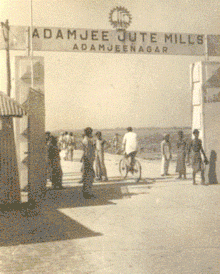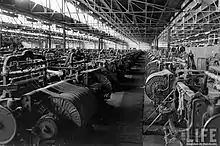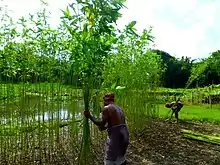Jute Industry in Bangladesh
Jute Industry in Bangladesh is an industry that is historically and culturally important that once was the biggest industry in the region but has declined since then. Jute was historically a major export item of Bangladesh but has declined since the 1970s. Exports have fallen as other countries grew jute and alternate products like plastic and hemp found more widespread use.[1] Bangladesh produces, as of 2018, 33 percent of the total worldwide production of jute.[2]
Important
Early history
Historically jute produced in Bengal was made into rope and clothes using local handlooms. During the Napoleonic wars (1803-1815) in Europe the supply of Russian flax linen to mills in Dundee, Scotland. The British needed a new source and jute was touted as a potential alternate to Russian flax. The problem with manufacturing jute fabrics in industrial mills was that Jute fabric was too course for the machines. The firm of Balfour and Melville developed a process to weaken the fabric by using water and whale fat. In 1838, Dundee mills received an order to manufacture sacks for sugar plantations in Dutch controlled Java. They produced jute burlap sacks for the order using the Balfour and Melville method. This generated demand and promoted jute from Bengal. Demand for jute further increased following the Crimean War (1853-1856).[3] In 1873, the British Raj formed a commission with led by HC Kerr to investigate the jute industry and jute cultivation in Bengal. Report on the Cultivation of, and Trade in, Jute in Bengal was published in 1877. The report suggested that large scale jute cultivation began in the 1840s in the Bengal region.[4]
.JPG.webp)
George Auckland, along with a Bengali partner, Shyamsunder Sen, established the first jute mill in the region 1855 in Rishra on the banks of the Hooghly River. The American Civil War had made it necessary to find an alternate fabric source. Jute was a good alternate as it was relatively cheaper and was sourced from a British colony, Bengal Presidency of British India. Jute mills were opened around Kolkata which rapidly grew in numbers in the later half of the 19th century. In 1882, there were 18 mills which had increased to 51 by 1901 and employed 10 thousand workers. The majority of the jute manufactured in the mills were exported to Australia, New Zealand, and the United States. The Jute industry had become the second largest industry in British India after the cotton industry and Kolkata became the centre of the jute trade. The majority of the factories were located outside Kolkata and were owned by foreigners.[3]
In the 1920s, jute prices rose dramatically which also lead to increased production. Jute prices fell in the 1930s despite the Indian Jute Mills Association trying to stop the price decline by reducing working hours.[3] The British Raj formed the Bengal Jute Inquiry Committee to create reports on the state of the Jute industry in Bengal in the 1930s during the Great Depression. It published two reports, one in 1934 and another in 1939. The report identified that low prices in one year led to lower production and higher prices the next year, this was followed subsequently by higher production and lower prices next year. The reports recommended the government restrict the production of jute.[5]
During World War Two production increased and at the end of the war there were 111 jute mills in the region. Jute production took place in the East Bengal while the majority of the mills were located in West Bengal. After the Partition of India, this became difficult as East Bengal joined Pakistan and West Bengal went to India. From 1947 to 1948, there was free trade between India and Pakistan which stopped when India declared Pakistan a foreign country and imposed border control. Trade between the two regions became difficult and Pakistan also started to develop Jute mills in East Bengal.[3] Before the Partition of India, there were 108 jute mills in Bengal and all of them were located in West Bengal. East Bengal despite being where the majority of the jute was cultivated was left with no mills after becoming part of Pakistan.[6] India and Pakistan tried halfheartedly to continue the Jute trade between East and West Bengal as both countries were trying to become selfsufficient in the production and processing of jute. India was trying to encourage domestic cultivation and Pakistan was trying to encourage domestic entrepreneurs to establish jute mills.[7]

Bawa Jute Mills Limited, Adamjee Jute Mills, and Victory Jute Products Limited were established in 1951 in East Bengal. Adamjee Jute Mills was built with financial support from the Pakistan Industrial Development Corporation. By 1960, the number of jute mills had increased to 14 and 12 of them was supported by Pakistan Industrial Development Corporation. The majority of these mills were founded by non-Bengalis. This generated some tension as the majority of the workers were Bengali which made the government realise that they needed to encourage more Bengali entrepreneurs. Abul Kashem Khan, the Minister of Industry, developed a plan to divide the Pakistan Industrial Development Corporation into two, West Pakistan Industrial Development Corporation and East Pakistan Industrial Development Corporation, to encourage more entrepreneurs from East Pakistan.[3]
The East Pakistan Industrial Development Corporation lowered the minimum number of looms required to open a factory and encouraged small Bengali entrepreneurs. This increased the number of jute mills owned by Bengalis. By 1970, East Pakistan had 77 jute mills which employed 170 thousand people. Pakistan earned 77 million rupees from the export of jute from East Pakistan and became the largest exporter of jute in the world. Jute as percentage of foreign revenue increased from .2 percent in 1952 to 46 percent in 1970.[3]
History

In 1971, East Pakistan became the independent country of Bangladesh following the Bangladesh Liberation war. The owners of jute mills from West Pakistan left Bangladesh and abandoned their jute mills. The government of Bangladesh ordered the Bangladesh Jute Board to take over those mills. The board appointed administrators for the mills. The administrators proved to be inept because they were appointed not based on their qualifications but political connections. In 1972, the government of Bangladesh nationalised all industries including jute mills and included socialism in the constitution of Bangladesh. The nationalised jute mills were placed under the Bangladesh Jute Mills Corporation.[3] Adamjee Jute Mills suffered from management problems after nationalisation There was absenteeism and issues with unions.[6]
Bangladesh Jute Mills Corporation was given the task of controlling the price, purchase, and sale of jute in Bangladesh. In the 1970s rising cost, the devaluation of taka, and corruption lead to Bangladesh Jute Mills Corporation incurring significant financial losses.[3] In 1973, the Government established the Jute Division and placed it under the Ministry of Finance. In 1976, the Jute Division was turned into the Ministry of Jute.[1]
In 1979, an expert committee of the government recommended that the government privatise the mills. From 1979 to 1980, three jute mills were returned to their previous owners and two were privatised. In the 1980s, the government provided subsidiaries and export bonus to encourage the industry to poor results. In 1982, the Government of Bangladesh returned 35 mills to private owners.[3] The jute grown in Bangladesh is used to produce Hessian fabric, Jute Carpets, and sacks.[8]
The World Bank recommended the Government of Bangladesh to appoint a firm to study the condition of the Jute industry in 1990 and accordingly a foreign consultant was appointed. According to the study, the jute industry had a liability of 20.75 billion taka with local banks and almost 13 billion taka was liability was held by state owned jute mills under Bangladesh Jute Mills Corporation and rest were held by private jute mills. The study recommended reduction in capacity and privatisation of all government held jute mills. The World Bank offered a loan, US$250 million, to implement these and some other recommendations. The government of Bangladesh closed down four mills and made funds available to state owned mills so that they could reduce their workforce. These did not reduce losses for the jute mills and the government failed to turn profit. The private jute mills were also under performing and two were closed down.[3]
Current state
In 2002, the Government closed down Adamjee Jute Mills, the largest jute mill in Bangladesh. Despite this, the remaining jute mills are still losing making concerns for the government.[3] By 2006, the Government of Bangladesh had shares in 78 percent of jute mills in Bangladesh and owns 29 mills completely.[9] In 2010, the Government of Bangladesh made it mandatory for wholesale manufacturers and sellers to pack rice, sugar, wheat, and fertilisers in jute bags. This requirement was expanded to include animal feed in 2018.[10]
In 2018, Bangladesh Jute Mills Corporation recommended the Ministry of Jute and Textiles form a 100 billion taka fund, Jute Sector Development Fund, to develop the jute industry and provide low cost loans. The Jute industry exports close to a billion dollars of product from Bangladesh every year.[11] In January 2018, the Government of Bangladesh imposed a ban on the export of raw/unprocessed jute to ensure adequate supply for the local market. The export ban was lifted in June 2019 following the demands of Bangladesh Jute Association.[12]
From 2010 to 2019, the Government of Bangladesh has given to about 7.5 billion taka to the Bangladesh Jute Mills Corporation. The corporation has not been able to turn profit, and it has been experiencing losses every year since 1980 with the exception of 2010-11 fiscal year. The Daily Star described the Bangladesh Jute Mills Corporation as "bottomless pit".[13]

The private sector in Bangladesh are taking a renewed interest in jute as demand for biodegrable and sustainable natural fabric grows. Khiyoo Fashion House, a Bangladeshi company, is making garments and shoes using jute.[14] In 2017, India imposed anti-dumping tariffs on jute hessian fabric, bags and yarn. In 2019, India expanded anti-dumping tariffs by imposing US$125.21 on per tonne of jute sacks. This led to concerns being expressed by Bangladesh Jute Mills Association and Bangladesh Jute Spinners Association as India was a major destination for Bangladeshi jute.[15] Janata Jute Mills and Akij Jute Mills are the two largest private jute mills in Bangladesh.[16]
Research
Bangladesh Jute Research Institute, founded in 1936, is a government research institute and the oldest mono corp research institute in Bangladesh. It was founded by Indian Central Jute Committee in Dhaka Farms as Jute Research Laboratory. It was upgraded by Pakistan Central Jute Committee and renamed to Jute Research Institute in 1951.[17] In 2010, a research team decoded the genome of jute. The team was led by Maqsudul Alam, a Bangladeshi professor at the University of Hawaii and included researchers from Bangladesh Jute Research Institute, Datasoft, and the University of Dhaka.[18]
NatUp Fibres, a company based in Normandy, France, has research using jute to make interior components for cars. The components are currently made from flax, which is relatively more expensive.[19] Golden Fibres Trade Centre exports Bangladeshi jute to car manufacturers in Germany. Bangladesh meets about 10 percent of the automobile industries demand for jute as of 2018.[20]
In 2018, the chief scientific officer at Bangladesh Jute Mills Corporation, Dr Mubarak Ahmad Khan, developed a polymer using jute that could be used to manufacture biodegrade plastic bag, called Sonali Bag.[21]
References
- Abdullah, ABM; Islam, Md. Anwarul. "Jute". en.banglapedia.org. Banglapedia. Retrieved 2019-08-24.
- "Jute is our golden future". Dhaka Tribune. 7 March 2018. Retrieved 25 August 2019.
- Islam, Mufakharul. "Jute Industry". en.banglapedia.org. Banglapedia. Retrieved 24 August 2019.
- Ali, M Wazed. "Jute Report, 1877". en.banglapedia.org. Banglapedia. Retrieved 2019-08-24.
- Rahim, Enayetur. "Bengal Jute Inquiry Committee Reports". en.banglapedia.org. Banglapedia. Retrieved 24 August 2019.
- "Adamjee Jute Mill". en.banglapedia.org. Banglapedia. Retrieved 24 August 2019.
- Sengupta, Anwesha (29 July 2019). "Unthreading Partition: The politics of jute sharing between two Bengals". The Daily Star. Retrieved 25 August 2019.
- Habibullah, M. "Jute Carpet". en.banglapedia.org. Banglapedia. Retrieved 2019-08-24.
- Bagchi, Jayanta (2006). Jute, Regional Focus. I. K. International Pvt Ltd. p. 30. ISBN 9788188237760. Retrieved 25 August 2019.
- Parvez, Sohel (12 August 2018). "Govt widens reach of jute packaging law". The Daily Star. Retrieved 25 August 2019.
- "Govt plans Tk 10,000cr fund for jute sector". The Daily Star. 27 June 2018. Retrieved 25 August 2019.
- "Govt lifts ban on export of uncut raw jute". The Daily Star. 13 June 2019. Retrieved 25 August 2019.
- "BJMC burdened with losses". The Daily Star. 15 May 2019. Retrieved 25 August 2019.
- "The Reincarnation of Jute". The Daily Star. 15 May 2018. Retrieved 25 August 2019.
- "India slaps anti-dumping duty on jute cloth". The Daily Star. 20 June 2019. Retrieved 25 August 2019.
- "Bangladesh may lose market in diversified jute products". The Daily Star. 26 November 2013. Retrieved 25 August 2019.
- Kabir, SM Humayun. "Bangladesh Jute Research Institute". en.banglapedia.org. Banglapedia. Retrieved 24 August 2019.
- Ahmed, Reaz (17 June 2010). "Jute genome decoded". The Daily Star. Retrieved 25 August 2019.
- Habib, Wasim Bin (11 April 2019). "Making Car Interior Components: Jute fibre shows huge potential". The Daily Star. Retrieved 25 August 2019.
- Mirdha, Refayet Ullah. "Car brands fond of Bangladeshi jute". The Daily Star. Retrieved 25 August 2019.
- "Forget polythene!". The Daily Star. 8 April 2018. Retrieved 25 August 2019.
